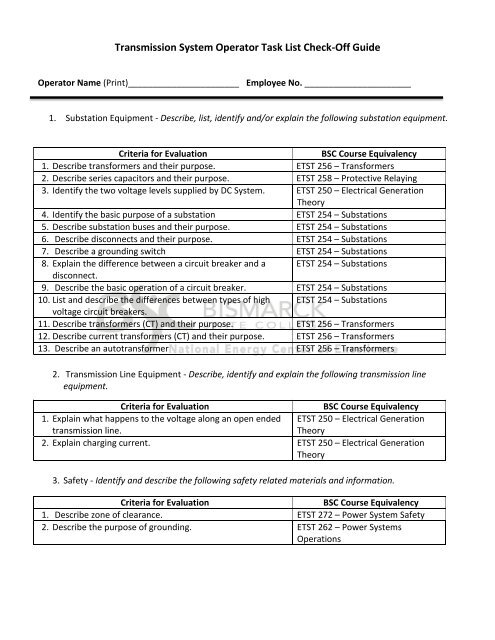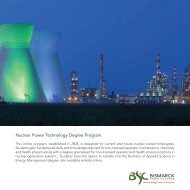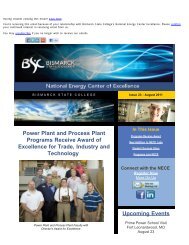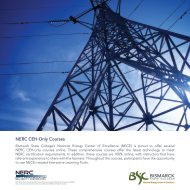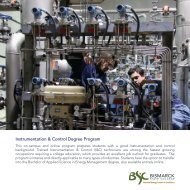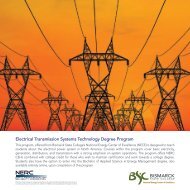Transmission System Operator Task List Check-Off Guide
Transmission System Operator Task List Check-Off Guide
Transmission System Operator Task List Check-Off Guide
You also want an ePaper? Increase the reach of your titles
YUMPU automatically turns print PDFs into web optimized ePapers that Google loves.
<strong>Transmission</strong> <strong>System</strong> <strong>Operator</strong> <strong>Task</strong> <strong>List</strong> <strong>Check</strong>-<strong>Off</strong> <strong>Guide</strong><br />
<strong>Operator</strong> Name (Print)_______________________ Employee No. ______________________<br />
1. Substation Equipment - Describe, list, identify and/or explain the following substation equipment.<br />
Criteria for Evaluation<br />
BSC Course Equivalency<br />
1. Describe transformers and their purpose. ETST 256 – Transformers<br />
2. Describe series capacitors and their purpose. ETST 258 – Protective Relaying<br />
3. Identify the two voltage levels supplied by DC <strong>System</strong>. ETST 250 – Electrical Generation<br />
Theory<br />
4. Identify the basic purpose of a substation ETST 254 – Substations<br />
5. Describe substation buses and their purpose. ETST 254 – Substations<br />
6. Describe disconnects and their purpose. ETST 254 – Substations<br />
7. Describe a grounding switch ETST 254 – Substations<br />
8. Explain the difference between a circuit breaker and a ETST 254 – Substations<br />
disconnect.<br />
9. Describe the basic operation of a circuit breaker. ETST 254 – Substations<br />
10. <strong>List</strong> and describe the differences between types of high ETST 254 – Substations<br />
voltage circuit breakers.<br />
11. Describe transformers (CT) and their purpose. ETST 256 – Transformers<br />
12. Describe current transformers (CT) and their purpose. ETST 256 – Transformers<br />
13. Describe an autotransformer ETST 256 – Transformers<br />
2. <strong>Transmission</strong> Line Equipment - Describe, identify and explain the following transmission line<br />
equipment.<br />
Criteria for Evaluation<br />
BSC Course Equivalency<br />
1. Explain what happens to the voltage along an open ended ETST 250 – Electrical Generation<br />
transmission line.<br />
Theory<br />
2. Explain charging current. ETST 250 – Electrical Generation<br />
Theory<br />
3. Safety - Identify and describe the following safety related materials and information.<br />
Criteria for Evaluation<br />
BSC Course Equivalency<br />
1. Describe zone of clearance. ETST 272 – Power <strong>System</strong> Safety<br />
2. Describe the purpose of grounding. ETST 262 – Power <strong>System</strong>s<br />
Operations
4. Relaying - Describe, explain and identify relaying<br />
Criteria for Evaluation<br />
BSC Course Equivalency<br />
1. Explain the function of protective relays ETST 258 – Protective Relaying<br />
2. Describe primary and secondary relaying ETST 258 – Protective Relaying<br />
3. Describe relays including differential, distance, mechanical,<br />
voltage, frequency, and overcurrent.<br />
5. Voltage Control - Describe, list, identify and/or explain voltage control.<br />
ETST 258 – Protective Relaying<br />
Criteria for Evaluation<br />
BSC Course Equivalency<br />
1. Describe the effect of shunt capacitors on a power system. ETST 270 – <strong>System</strong> <strong>Operator</strong> Work<br />
Practices<br />
2. Locate and describe generation reactive curves. ETST 270 – <strong>System</strong> <strong>Operator</strong> Work<br />
Practices<br />
3. Define nominal and normal voltage ENRT 106 – DC Fundamentals<br />
6. Operating and Emergency Procedures - Describe, define and identify the following procedures.<br />
Criteria for Evaluation<br />
1. Describe actions to be taken to reduce phase angle and<br />
allow line reclosing<br />
BSC Course Equivalency<br />
ETST 256 –Transformers


